

Multicoaching: Consultation, Training, Coaching. Multiple Intelligences: A Theory for Everyone. Being intelligent does not always mean that someone tests well -- a problem with which teachers and school administrators have struggled since the earliest days of organized education.
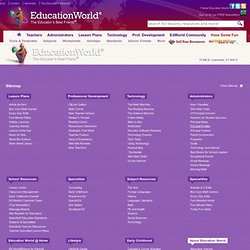
Howard Gardner's theory of multiple intelligences helps educators think differently about "IQ," and about what being "smart" means. The theory is changing the way some teachers teach. When Howard Gardner's book, Frames of Mind: The Theory of Multiple Intelligences (Basic Books, 1983) burst on the scene, it seemed to answer many questions for experienced teachers. We all had students who didn't fit the mold; we knew the students were bright, but they didn't excel on tests. Multiple Intelligences Test and Learning Styles Information. Index. MI Intro. ONE OF THE MOST COMPELLING, yet controversial new approaches to education reform is Multiple Intelligences Theory, or MI.

Conceived of by Howard Gardner of the Harvard Graduate School of Education and Harvard Project Zero, MI first swept the worlds of education, cognitive science and developmental psychology in 1983 with the publication of Gardner's treatise, Frames of Mind. In the decade since Frames, the work of Dr. Gardner and MI theory has shaken educators with a most fundamental question: What is intelligence? What is the the traditional view of intelligence? How has this view impacted schools historically? I'd like to examine other reform styles. EdWeb: Exploring Technology and School Reform, by Andy Carvin. The One and Only Surfaquarium - Multiple Intelligences. New City School - Home. Howard Gardner, multiple intelligences and education. Howard Gardner, multiple intelligences and education.
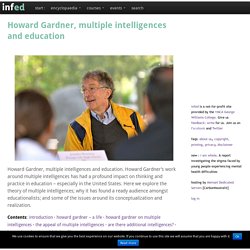
Howard Gardner’s work around multiple intelligences has had a profound impact on thinking and practice in education – especially in the United States. How Technology Enhances Howard Gardner's Eight Intelligences. MIResearch.org - Home. Audio production and publishing company dedicated to ideas that deepen our understanding of the human experience. Excellence Ethics Engagement. Project Zero. Gardner's Multiple Intelligences. Howard Gardner of Harvard has identified seven distinct intelligences.
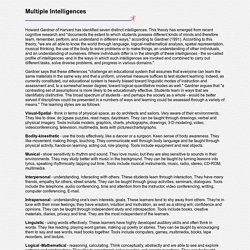
This theory has emerged from recent cognitive research and "documents the extent to which students possess different kinds of minds and therefore learn, remember, perform, and understand in different ways," according to Gardner (1991). According to this theory, "we are all able to know the world through language, logical-mathematical analysis, spatial representation, musical thinking, the use of the body to solve problems or to make things, an understanding of other individuals, and an understanding of ourselves. What are Multiple Intelligences? Multiple Intelligences by Dr. Thomas Armstrong. Multiple Intelligences The theory of multiple intelligences was developed in 1983 by Dr.
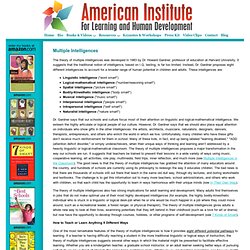
Howard Gardner, professor of education at Harvard University. It suggests that the traditional notion of intelligence, based on I.Q. testing, is far too limited. Instead, Dr. Gardner proposes eight different intelligences to account for a broader range of human potential in children and adults. Linguistic intelligence ("word smart") Logical-mathematical intelligence ("number/reasoning smart") Spatial intelligence ("picture smart") Bodily-Kinesthetic intelligence ("body smart") Musical intelligence ("music smart") Interpersonal intelligence ("people smart") Intrapersonal intelligence ("self smart") Naturalist intelligence ("nature smart") Dr.
Learnng Styles take your test. Click here to take your learning styles test Information about learning styles and Multiple Intelligence (MI) is helpful for everyone especially for people with learning disabilities and Attention Deficit Disorder.
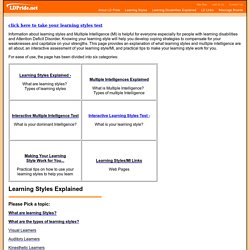
Knowing your learning style will help you develop coping strategies to compensate for your weaknesses and capitalize on your strengths. This page provides an explanation of what learning styles and multiple intelligence are all about, an interactive assessment of your learning style/MI, and practical tips to make your learning style work for you. Multiple Intelligences. Howard Gardner, multiple intelligences and education.
Emotional Intelligence Quiz. Emotional Intelligence Test. This is an interactive version of the Personality-Based Emotional Intelligence Test.
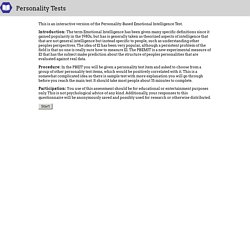
Introduction: The term Emotional Intelligence has been given many specific definitions since it gained popularity in the 1980s, but has is generally taken as theorized aspects of intelligence that that are not general intelligence but instead specific to people, such as understanding other peoples perspectives. The idea of EI has been very popular, although a persistent problem of the field is that no one is really sure how to measure EI. The PBEMIT is a new experimental measure of EI that has the subject make prediction about the structure of peoples personalities that are evaluated against real data.
Procedure: In the PBEIT you will be given a personality test item and asked to choose from a group of other personality test items, which would be positively correlated with it. Psychometriclab. Emotional Intelligence. Aptitude Assessment. What is Aptitude Assessment?
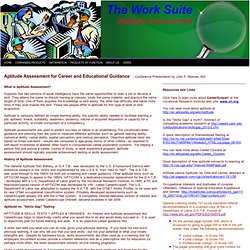
Suppose that two persons of equal intelligence have the same opportunities to learn a job or develop a skill. They attend the same on-the-job training or classes, study the same material, and practice the same length of time. One of them acquires the knowledge or skill easily; the other has difficulty and takes more time, if they ever master the skill. These two people differ in aptitude for this type of work or skill acquisition. Aptitude is variously defined as innate learning ability, the specific ability needed to facilitate learning a job, aptness, knack, suitability, readiness, tendency, natural or acquired disposition or capacity for a particular activity, or innate component of a competency.
Aptitude assessments are used to predict success or failure in an undertaking. History of Aptitude Assessment The General Aptitude Test Battery, or G.A.T.B . was developed by the U.S. Aptitude vs. Measuring Aptitude. ERIC Identifier: ED328608 Publication Date: 1990-12-00 Author: Macklem, Gayle L.

Source: ERIC Clearinghouse on Tests Measurement and Evaluation Washington DC., American Institutes for Research Washington DC. Measuring Aptitude. ERIC Digest. The terms intelligence, ability, and aptitude are often used interchangeably to refer to behavior that is used to predict future learning or performance. However, subtle differences exist between the terms. Robert Pease: Personal Reflections on Testing. Multipotentiality: multiple talents, multiple challenges. One of the myths of highly talented people is they can choose whatever personal and career paths they want, and realize their abilities without hindrance.

It doesn’t exactly work that easily. In her Unwrapping the Gifted post “ Multipotentiality ,” K-12 gifted education specialist Tamara Fisher quotes Bryant (a pseudonym), a graduating senior who lists his possible future careers as “applied psychologist, scientific psychologist, college teacher, philosophy, mathematics, architect, engineer.” He says, “I find it difficult to choose between careers because I fear how large the choice is. The Too Many Aptitudes Problem. The Too Many Aptitudes Problem (Condensed from Danger: High Voltage) Hank Pfeffer[Out of date contact information omitted.] Talent is a force, not a tool.
Talent is neither good nor bad. Being multi-talented is a very mixed blessing. Standardized tests: Aptitude, Intelligence, Achievement. Active Intelligence Consultancy - Home. REACHING THE SECOND TIER: LEARNING AND TEACHING STYLES IN COLLEGE SCIENCE EDUCATION. Felder, Richard, "Reaching the Second Tier: Learning and Teaching Styles in College Science Education. "J. College Science Teaching, 23(5), 286-290 (1993). Richard M. Felder Department of Chemical Engineering North Carolina State University Raleigh, NC 27695-7905 In her recent study of college science instruction, Sheila Tobias [19] defines two tiers of entering college students, the first consisting of those who go on to earn science degrees and the second those who have the initial intention and the ability to do so but instead switch to nonscientific fields. The thrust of Tobias's study is that introductory science courses are responsible for driving off many students in the second tier.
Recent educational research provides theoretical support for Tobias's assertions, which are based largely on anecdotal accounts. Felder & Soloman: Learning Styles and Strategies. Richard M. Felder Hoechst Celanese Professor of Chemical Engineering North Carolina State University Barbara A. Soloman Coordinator of Advising, First Year College North Carolina State University Active learners tend to retain and understand information best by doing something active with it--discussing or applying it or explaining it to others. Reflective learners prefer to think about it quietly first. Learning Styles. You have probably noticed that when you try to learn something new that you prefer to learn by listening to someone talk to you about the information.
Some people prefer to read about a concept to learn it; others need to see a demonstration of the concept. Learning Style Theory proposes that different people learn in different ways and that it is good to know what your own preferred learning style is. Some links have been provided below for you to follow to learn more about learning styles. There are a variety of instruments that help you identify your learning style and you may prefer to do them on line, or you may want to stop in the Career Service Office, Campus Center 21, to talk to a real person and use a real pencil to fill out a Learning Style Inventory!
But first, check out the resources below. Student Learning and the Myers-Briggs Type Indicator. This file discusses briefly (1) the four dimensions underlying the Myers-Briggs Type Indicator (MBTI), and (2) several teaching approaches that will appeal to different MBTI profiles. The 126 item Myers-Briggs Type Indicator (MBTI), Form G, is the most reliable method for assessing student learning style. The MBTI provides data on four sets of preferences. These preferences result in 16 learning styles, or types. A type is the combination of the four preferences. The most common MBTI type for business undergraduates is the ESTJ, the Extraverted-Sensing-Thinking-Judger. The MBTI instrument should be administered in the first or second class period by the counseling center at your school.
Indiana State University : CIRT : Learning Styles. Paragon Learning Style Inventory. Three Different Learning Styles. Clemson University. Learning styles and preferences: Learning Styles Profiler. Peter Honey Publications (Honey and Mumford) Hay Group. Multiple Intelligence Institute - MII. Theory of multiple intelligences.